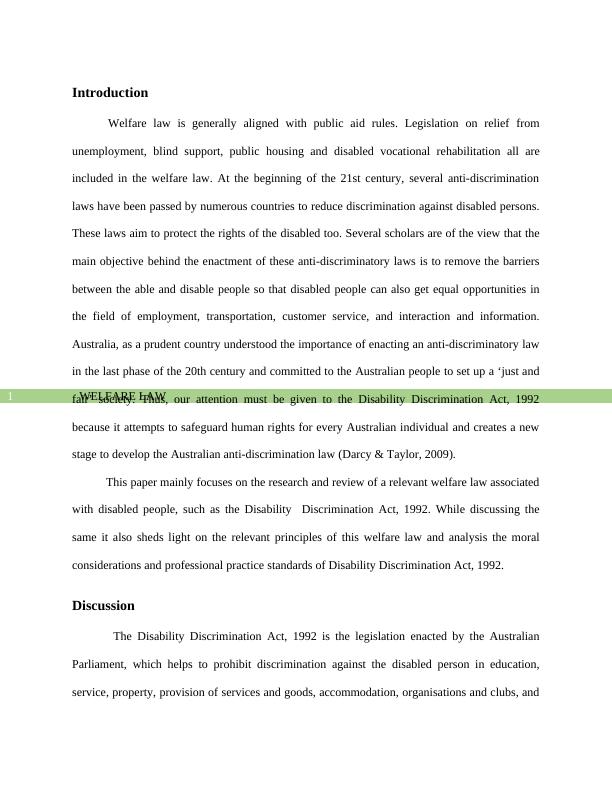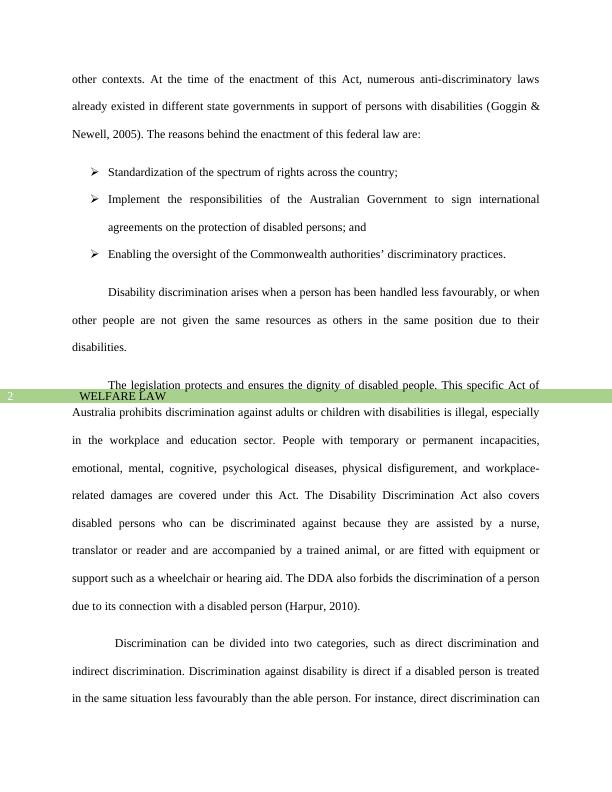Overview of Welfare Law - Assignment
11 Pages2717 Words14 Views
Added on 2022-08-13
Overview of Welfare Law - Assignment
Added on 2022-08-13
ShareRelated Documents
Running head: WELFARE LAW
WELFARE LAW
Name of the Student
Name of the University
Authors Note
WELFARE LAW
Name of the Student
Name of the University
Authors Note

WELFARE LAW1
Introduction
Welfare law is generally aligned with public aid rules. Legislation on relief from
unemployment, blind support, public housing and disabled vocational rehabilitation all are
included in the welfare law. At the beginning of the 21st century, several anti-discrimination
laws have been passed by numerous countries to reduce discrimination against disabled persons.
These laws aim to protect the rights of the disabled too. Several scholars are of the view that the
main objective behind the enactment of these anti-discriminatory laws is to remove the barriers
between the able and disable people so that disabled people can also get equal opportunities in
the field of employment, transportation, customer service, and interaction and information.
Australia, as a prudent country understood the importance of enacting an anti-discriminatory law
in the last phase of the 20th century and committed to the Australian people to set up a ‘just and
fair’ society. Thus, our attention must be given to the Disability Discrimination Act, 1992
because it attempts to safeguard human rights for every Australian individual and creates a new
stage to develop the Australian anti-discrimination law (Darcy & Taylor, 2009).
This paper mainly focuses on the research and review of a relevant welfare law associated
with disabled people, such as the Disability Discrimination Act, 1992. While discussing the
same it also sheds light on the relevant principles of this welfare law and analysis the moral
considerations and professional practice standards of Disability Discrimination Act, 1992.
Discussion
The Disability Discrimination Act, 1992 is the legislation enacted by the Australian
Parliament, which helps to prohibit discrimination against the disabled person in education,
service, property, provision of services and goods, accommodation, organisations and clubs, and
Introduction
Welfare law is generally aligned with public aid rules. Legislation on relief from
unemployment, blind support, public housing and disabled vocational rehabilitation all are
included in the welfare law. At the beginning of the 21st century, several anti-discrimination
laws have been passed by numerous countries to reduce discrimination against disabled persons.
These laws aim to protect the rights of the disabled too. Several scholars are of the view that the
main objective behind the enactment of these anti-discriminatory laws is to remove the barriers
between the able and disable people so that disabled people can also get equal opportunities in
the field of employment, transportation, customer service, and interaction and information.
Australia, as a prudent country understood the importance of enacting an anti-discriminatory law
in the last phase of the 20th century and committed to the Australian people to set up a ‘just and
fair’ society. Thus, our attention must be given to the Disability Discrimination Act, 1992
because it attempts to safeguard human rights for every Australian individual and creates a new
stage to develop the Australian anti-discrimination law (Darcy & Taylor, 2009).
This paper mainly focuses on the research and review of a relevant welfare law associated
with disabled people, such as the Disability Discrimination Act, 1992. While discussing the
same it also sheds light on the relevant principles of this welfare law and analysis the moral
considerations and professional practice standards of Disability Discrimination Act, 1992.
Discussion
The Disability Discrimination Act, 1992 is the legislation enacted by the Australian
Parliament, which helps to prohibit discrimination against the disabled person in education,
service, property, provision of services and goods, accommodation, organisations and clubs, and

WELFARE LAW2
other contexts. At the time of the enactment of this Act, numerous anti-discriminatory laws
already existed in different state governments in support of persons with disabilities (Goggin &
Newell, 2005). The reasons behind the enactment of this federal law are:
Standardization of the spectrum of rights across the country;
Implement the responsibilities of the Australian Government to sign international
agreements on the protection of disabled persons; and
Enabling the oversight of the Commonwealth authorities’ discriminatory practices.
Disability discrimination arises when a person has been handled less favourably, or when
other people are not given the same resources as others in the same position due to their
disabilities.
The legislation protects and ensures the dignity of disabled people. This specific Act of
Australia prohibits discrimination against adults or children with disabilities is illegal, especially
in the workplace and education sector. People with temporary or permanent incapacities,
emotional, mental, cognitive, psychological diseases, physical disfigurement, and workplace-
related damages are covered under this Act. The Disability Discrimination Act also covers
disabled persons who can be discriminated against because they are assisted by a nurse,
translator or reader and are accompanied by a trained animal, or are fitted with equipment or
support such as a wheelchair or hearing aid. The DDA also forbids the discrimination of a person
due to its connection with a disabled person (Harpur, 2010).
Discrimination can be divided into two categories, such as direct discrimination and
indirect discrimination. Discrimination against disability is direct if a disabled person is treated
in the same situation less favourably than the able person. For instance, direct discrimination can
other contexts. At the time of the enactment of this Act, numerous anti-discriminatory laws
already existed in different state governments in support of persons with disabilities (Goggin &
Newell, 2005). The reasons behind the enactment of this federal law are:
Standardization of the spectrum of rights across the country;
Implement the responsibilities of the Australian Government to sign international
agreements on the protection of disabled persons; and
Enabling the oversight of the Commonwealth authorities’ discriminatory practices.
Disability discrimination arises when a person has been handled less favourably, or when
other people are not given the same resources as others in the same position due to their
disabilities.
The legislation protects and ensures the dignity of disabled people. This specific Act of
Australia prohibits discrimination against adults or children with disabilities is illegal, especially
in the workplace and education sector. People with temporary or permanent incapacities,
emotional, mental, cognitive, psychological diseases, physical disfigurement, and workplace-
related damages are covered under this Act. The Disability Discrimination Act also covers
disabled persons who can be discriminated against because they are assisted by a nurse,
translator or reader and are accompanied by a trained animal, or are fitted with equipment or
support such as a wheelchair or hearing aid. The DDA also forbids the discrimination of a person
due to its connection with a disabled person (Harpur, 2010).
Discrimination can be divided into two categories, such as direct discrimination and
indirect discrimination. Discrimination against disability is direct if a disabled person is treated
in the same situation less favourably than the able person. For instance, direct discrimination can

WELFARE LAW3
occur when a person is rejected because of his disability and who is the appropriate person for
the job.
On the other hand, indirect discrimination can occur if employers or facility providers
create conditions, standards and policies that seem to treat everyone equally, but that still
disadvantage certain people due to their disabilities. For instance, it could be indirect
discrimination for a Deaf employee to join meetings when they are not equipped with Auslan
interpreters to understand what is being said. While without an interpreter they could attend the
conference, but they would be badly disadvantaged because they had trouble in attending (Basser
& Jones, 2002).
The Disability Discrimination Act, 1992 sought to end all discrimination against persons
with disabilities in many fields and to expand the rights of persons with disabilities. However,
the main principles of this Act are:
Mark discrimination against persons with disabilities illegal in relation to jobs or the
supply of goods, facilities and services;
Mark discrimination against persons with disabilities illegal in controlling, purchasing,
renting or disposing of land or property;
Ensure the disability jobs requirements are complied with; and
Create a National Council for Disability.
It has been observed and stated by many scholars that for people with disabilities, the
Disabilities Discrimination Act, 1992 paved the way for major changes in working, and
employee attitudes and actions. It ensures that employers are not permitted, without valid cause,
to discriminate against a person with a disability because of his/her incapacity. Even, if the
occur when a person is rejected because of his disability and who is the appropriate person for
the job.
On the other hand, indirect discrimination can occur if employers or facility providers
create conditions, standards and policies that seem to treat everyone equally, but that still
disadvantage certain people due to their disabilities. For instance, it could be indirect
discrimination for a Deaf employee to join meetings when they are not equipped with Auslan
interpreters to understand what is being said. While without an interpreter they could attend the
conference, but they would be badly disadvantaged because they had trouble in attending (Basser
& Jones, 2002).
The Disability Discrimination Act, 1992 sought to end all discrimination against persons
with disabilities in many fields and to expand the rights of persons with disabilities. However,
the main principles of this Act are:
Mark discrimination against persons with disabilities illegal in relation to jobs or the
supply of goods, facilities and services;
Mark discrimination against persons with disabilities illegal in controlling, purchasing,
renting or disposing of land or property;
Ensure the disability jobs requirements are complied with; and
Create a National Council for Disability.
It has been observed and stated by many scholars that for people with disabilities, the
Disabilities Discrimination Act, 1992 paved the way for major changes in working, and
employee attitudes and actions. It ensures that employers are not permitted, without valid cause,
to discriminate against a person with a disability because of his/her incapacity. Even, if the

End of preview
Want to access all the pages? Upload your documents or become a member.
Related Documents
Management of Workplace Conflicts: Assessmentlg...
|30
|6763
|38
Workplace Diversity Tasks 2022lg...
|15
|2668
|26
Legal and Social Policy Assignmentlg...
|7
|1611
|86
BSBSUS301 Implement and Monitor Environmentally Sustainable Work Practiceslg...
|12
|3176
|70
BSBGMT616 Health and safetylg...
|31
|6224
|27
BSBLED401 - Develop Teams and Individualslg...
|11
|3096
|65
